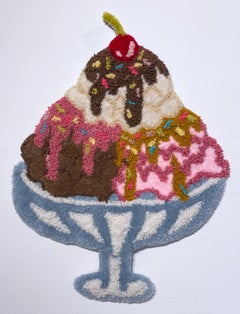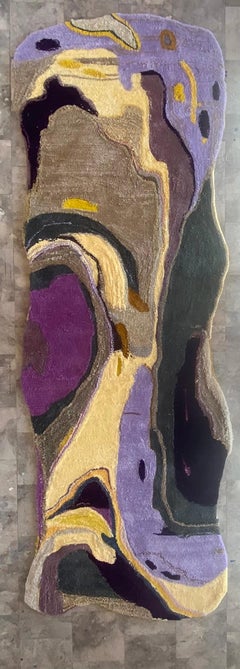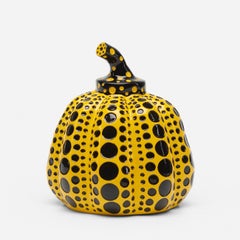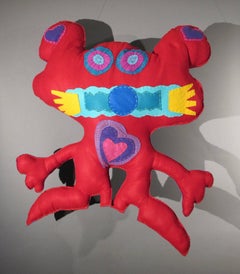Felt More Art
to
1
1
1
Overall Width
to
Overall Height
to
3
10
8
3
1
1
801
1,221
1,023
768
738
1
3
Style: Contemporary
Medium: Felt
CJ Hendry Flower Market 2.0 ALL 27 FLOWERS Limited Edition NYC Pop Up
Located in Draper, UT
CJ Hendry Flower Market 2.0 ALL 27 FLOWERS Limited Edition NYC Pop Up
Materials
Polyester
Size
17 × 7 × 5 in 43.2 × 17.8 × 12.7 cm
Rarity
Unknown edition
Medium
Sculpture
Condit...
Category
2010s Contemporary Felt More Art
Materials
Wire
Bake Sale: Ice Cream (20232), tufted wall art, textile, fiber, yarn, pink, soft
By SarahGrace
Located in Jersey City, NJ
Bake Sale: Ice Cream (2023), tufted art, textile, fiber, yarn, soft sculpture, pink, teal, wall or tabletop rug
"Bake Sale: Ice Cream" by SarahGrace is a hand tufted wall...
Category
2010s Contemporary Felt More Art
Materials
Fabric, Yarn, Felt
"Portal to a Geode" -- Handmade Rug by Jenny Day
By Jenny Day
Located in New Orleans, LA
JENNY DAY earned an MFA in Painting and Drawing from the University of Arizona, a BFA in Painting from the University of Alaska Fairbanks and a BA in Environmental Studies from the U...
Category
21st Century and Contemporary Contemporary Felt More Art
Materials
Wool, Felt
Related Items
YAYOI KUSAMA - Pumpkin (Yellow). Conceptualism, Contemporary, Modern art, Dots
By Yayoi Kusama
Located in Madrid, Madrid
PUMPKIN (YELLOW)
Date of creation: 2016
Medium: Resin sculpture
Edition: Open
Size: 9,5 x 7,5 cm
Observations: Sculpture created with high quality resin stamped on its base with Yayo...
Category
2010s Other Art Style Felt More Art
Materials
Resin
$717 Sale Price
20% Off
H 3.75 in W 2.96 in D 2.96 in
Train Engine Folk Outsider Art Deco Assemblage Found Objects Contemporary Statue
Located in New York, NY
Train Engine Folk Outsider Art Deco Assemblage Found Objects Contemporary Statue
Actual Dimensions: 8.75 X 19.75 X 5.75 inches
Michael Riley (Mike Riley) (American, born 1957). A model train engine statue in mixed media. Metal, wood, and other elements. An Art Deco Moderne style design produced from found objects, including garden hose fitting, sliding door track, trombone instrument counter weights, flute instrument...
Category
2010s Assemblage Felt More Art
Materials
Steel, Stainless Steel
$3,900
H 9 in W 20 in D 6 in
Pair Japanese Lacquered Maki-e Meiji Period Cabinets 漆器 蒔絵 塗物 漆塗
Located in Cotignac, FR
A pair of Meiji period, late 19th Century Lacquerware (漆器, shikki) miniature cabinets on stands. The decorative panels are of very fine quality. The cabinets are a 'true pair' that i...
Category
Late 19th Century Edo Felt More Art
Materials
Wood, Lacquer
Curtis Jere Copper Toned Metal Tree Sculpture c.1970s
By Curtis Jeré
Located in San Francisco, CA
Curtis Jere Copper Toned Metal Tree Sculpture c.1970s
Tall and elegant tree sculpture by listed American artist Curtis Jere.
The tree is made from...
Category
Mid-20th Century Naturalistic Felt More Art
Materials
Metal
$1,850 Sale Price
32% Off
H 73 in W 31 in D 5 in
"Take Out", Takeout Container Sculpture Cast in Porcelain with a Celadon Glaze
By Yoonmi Nam
Located in Philadelphia, PA
"Take Out "is an original free-standing sculpture by Yoonmi Nam as part of the artist's ongoing "Cairn" series. To create the work, the artist the slip casts the ceramic by pouring ...
Category
21st Century and Contemporary Contemporary Felt More Art
Materials
Porcelain
$700
H 2.5 in W 8.25 in D 8.25 in
Antique, 19th C. Peugeot Frères Brevetés French Coffee Grinder Table Sculpture
Located in Surfside, FL
This is being sold as a piece of (functional?) decorator table sculpture for a kitchen or restaurant. I do not know if or how it works. the wheel and gears turn. It might be missing a cover on the handle. It is a lovely antique piece. Made in France.
A halfcentury before they produced their first car, the Peugeot brothers were making coffee grinders, continuing to do so for over 100years. In 1840 the Peugeots produced their first moulin a
cafe out of a combination of metal and wood. The beans were inserted into the metal
hopper up top; metal gears were turned by a woodenknob-capped metal...
Category
Late 19th Century Modern Felt More Art
Materials
Metal, Brass
$850
H 14.5 in W 14 in D 8.5 in
Wool Felt Applique Israeli Folk Art Signed Tapestry Kopel Gurwin Bezalel School
By Kopel Gurwin
Located in Surfside, FL
This depicts KIng David reciting Psalms, Hallelujah in Hebrew
Kopel Gurwin (Hebrew: קופל גורבין) (1923–1990) was an Israeli tapestry wall hanging, painter and graphic artist.
Kopel (Kopke') Gurwin (Gurwitz) was born and raised in Vilna, the capital of Lithuania. He spoke Yiddish at home, but simultaneously studied Hebrew at their school which was part of the Tarbut educational network. Kopel was active in the Hashomer Hatzair youth movement. In the 1930s, as a teenager, Kopel helped his parents with the home finances by working in a suit workshop, there he first encountered the art of sewing.
With the outbreak of the Second World War and the German invasion of Vilna, the Jews were imprisoned in camps and ghettos. Kopel and his brother Moshe were separated from their parents and were put to work in coal mines and peat. Kopel's parents were taken to the Stutthof Nazi concentration camp where they died of typhus within a month of each other. Kopel's 12-year-old sister Chava was turned over to the Germans by a Polish family and murdered.
The brothers were arrested by the Germans, but were saved thanks to the connections of Nina Gerstein, Kopel's drama teacher. They hid in an attic until they were discovered, fled and moved to Riga, where they were caught and sent to the Stutthof concentration camp where they were imprisoned until the end of the war. They were put to work maintaining and cleaning trains and took part in one of the death marches. In July 1946, Kopel and Moshe sailed to Helsingborg, Sweden, as part of operation "Folke Bernadotte", in which Sweden took in ill survivors for rehabilitation. Once he recovered, Kopel worked in a publishing house and later was appointed director of the local branch of the Halutz movement.
In 1950 Kopel and Moshe made aliyah to Israel. Kopel worked as a survey for the Survey of Israel Company. In 1951, he enlisted to the Communication Corps and served as a military draftsman. There he won first prize for the design of the front cover of the Communication Corps bulletin.
With his discharge from the army at 29 he started studying drawing and graphics at the Bezalel Academy of Arts and Design in Jerusalem. Among his teachers were Isidor Ascheim, Shlomo Vitkin, Yossi Stern and Jacob Steinhardt. At the end of his first year of study, Kopel won the Reuben and Sarah Lif Excellence Award in written studies. During his studies he also won additional prizes: In 1956 he won first prize from the Lethem Foundation in California for poster design. Later the same year, Kopel won the Hermann Struck prize for his drawing on the theme of Jerusalem.
In 1957 he won an additional first prize from the Lethem Foundation and second place from the printing company Ortzel for a drawing for a Jewish New Year greeting card. In 1958 he won first prize in a competition to design a poster for Tel Aviv's jubilee.
Two years later he won three other awards: First and third prize for designing a poster for Israel Independence Day, celebrating 12 years of the State of Israel.
Also that year Kopel won first prize for a poster to mark the 25th Zionist Congress.
In 1964 he entered the Independence Day poster competition on the theme of aliyah and won first and second prize. Four years later he again entered the competition on the theme of 20 years of Israel's independence and won first prize. The poster was styled like a Holy Ark curtain with two lions and a menorah at its centre. This poster appeared on the cover of the famous book Jewish Art and Civilization, edited by Geoffrey Wigoder as well as the record Voices of 20 Years, 1948-1968, edited by Yossi Godard. In April 1971 he won first prize in the Independence Day poster competition for the fourth time.
Kopel's Folk Art tapestry won the Israeli Independence Day Poster Contest in 1968
With the completion of his studies at Bezalel Kopel moved to Tel Aviv and was hired by Shmuel Grundman's graphics and design studio. Grundman took him to Europe with him to design and supervise the construction of Israeli exhibition pavilions. During his time at Grundman's he discovered the fibrous felt from which he produced most of his wall hangings. At the 1964 Levant Fair exhibition he used felt stuck onto wooden panels for the first time.
The first felt wall hanging that Kopel produced was intended for the American Cultural Centre in Jerusalem and its theme was the United States Declaration of Independence. The wall hanging, which measured 2.85 X 1.85 meters, was stuck on a wooden panel. Kopel ordered rolls of felt from France and began work on wall hangings based on bible stories. He used a needle, hand sewing small even stitches with black embroidery thread which framed and highlighted every detail in the work, as well as using appliqué. The interior designer, Alufa Koljer-Elem, introduced him to Ruth Dayan who managed the shop Maskit in September 1967 he opened his first solo exhibition at the Maskit 6 gallery, in which 12 wall hangings were displayed.
In light of the exhibition at Maskit 6, Meira Gera, the director of artistic activity at the America-Israel Cultural Foundation, organized an additional exhibition of his works at the foundation's exhibition hall in New York City. The exhibition sparked immense press interest, and was also displayed for a few months at the New York Jewish Museum, from where it travelled throughout the United States.
Followed by the exhibition at the Delson-Richter gallery in Old Jaffa, which was later also exhibited at the Jerusalem Theatre.
Kopel's tapestry "The Time for Singing has Arrived" was printed on a UNICEF greeting card in 1978 and again in 1981.
The Israeli Philatelic Service issued three stamps based on three of Kopel's holy ark curtains and one stamp based on an Independence Day poster he designed.
Kopel's creations decorate a large number of synagogues, public buildings, hotels and private collections which were purchased in Israel and around the world. They have decorated, among others, the walls of the King David Hotel in Jerusalem, the VIP room at Ben Gurion Airport, the Kfar Saba theatre and the Plaza Hotel in Tel Aviv.
Israel has had a Vibrant Folk Art, Naive art scene for a long time now artists like Israel Paldi, Nahum Guttman, Reuven Rubin had naive periods. The most well know of the strict naive artists are Shalom of Safed, David Sharir, Irene Awret, Gabriel Cohen, Natan Heber, Michael Falk and Kopel Gurwin.
Exhibitions:
1995 The Knesset Jerusalem
1988 Temple Beth Shalom Miami, Florida
1988 University of Jewish Studies Los Angeles
1987 Israel Congregation on the Northern Coast Chicago
1985 Jerusalem Theatre Jerusalem
1984 Tenafly New Jersey
1983 Horace Richter Gallery Old Jaffa
1974 Jerusalem Theatre Jerusalem
1974 Delson Richter Gallery Old Jaffa
1972 University of Jewish Studies Miami, Florida
1971 Jewish Museum New York
1970 Norman Gallery Canada
1970 Sharei Tzedek Congregation Winnipeg, Canada
1970 Gallery of the Year Los Angeles
1970 Gallery of the Year Scottsdale
1969 Gleeman Gallery Chicago
1969 Israel Congregation of the Northern Coast Chicago
1967 Maskit 6 Tel Aviv
Prizes:
1971 First Independence Day poster 1971, 23 yeaes of the State of Israel
1969 Second International Tel Aviv poster...
Category
20th Century Folk Art Felt More Art
Materials
Wool, Felt
Italian Wool Felt Handmade Futurist Fortunato Depero Art Tapestry Wall Hanging
By Ivana Gaifas
Located in Surfside, FL
It is signed in a stitch Omaggio a Depero, Ivana, 2000
Fortunato Depero (1892 – 1960) was an Italian futurist artist and painter, writer, sculptor and graphic designer who worked in...
Category
20th Century Futurist Felt More Art
Materials
Wool, Felt, Thread
$1,800
H 16 in W 15.5 in
"CRAP" ("Text-i-monial" series by Charles Clary)
Located in Philadelphia, PA
"CRAP" is an original wall-hanging sculpture by Charles Clary as part of the artist's popular "Text-i-monial" series. To create the artwork, Clary hand cuts a series of individual sh...
Category
21st Century and Contemporary Contemporary Felt More Art
Materials
Paper, Wood Panel
Italian Wool Felt Handmade Futurist Fortunato Depero Art Tapestry Wall Hanging
By Ivana Gaifas
Located in Surfside, FL
It is signed in a stitch Omaggio a Depero, Ivana, 2000
Fortunato Depero (1892 – 1960) was an Italian futurist artist and painter, writer, sculptor and graphic designer who worked in...
Category
20th Century Futurist Felt More Art
Materials
Wool, Felt, Thread
$1,800
H 16 in W 15.5 in
"Evening Roost" Wildlife Bronze Sculpture of Green-Wing Teal Ducks Ed. 34/40
Located in Houston, TX
Naturalistic bronze wildlife sculpture by Texas based artist Ronnie Wells. The work features a pair of green-wing teal ducks by the water as they inspect a snail. Titled, signed, and...
Category
1980s Naturalistic Felt More Art
Materials
Bronze
$3,450
H 15 in W 20.75 in D 13 in
Pow!
By Keith Young
Located in Kansas City, MO
Keith Young
Pow!
Collage on Canvas; Rubber, Glue, Wood, Cotton Canvas
Year: 2022
Size: 12.25x11.5x3in
Signed by hand
COA provided
Ready to hang
Ref.: 924802-1134
-------------------...
Category
2010s Contemporary Felt More Art
Materials
Wire
Previously Available Items
"Peachy Keen", fiber, sculpture, handwoven, felting, orange, brown
Located in Franklin, MA
"Peachy Keen" is a 22 x 25 x 6 inch fiber sculpture made of handwoven wool, cotton, and nuno felting with a warm palette of peach, orange, and brown. A part of Vander Sluis' "Torso" series, this piece hangs on a wooden rod and is designed to be seen from both sides. Label with artist's signature is on the inside.
In her "Torso" series, Vander Sluis uses improvisational weaving and knitting to create fiber figures. The torso form...
Category
2010s Contemporary Felt More Art
Materials
Wool, Felt, Cotton
Free-Range Critter, soft sculpture, red and turquoise
By Kerry Green
Located in Santa Fe, NM
Soft sculpture, hand stitched, made of recycled materials in Santa Fe, New Mexico. Art to enjoy- Not a toy.
"These hybrid free-range critters originat...
Category
2010s Contemporary Felt More Art
Materials
Felt, Polyester
Gone
By Rebecca Reeves
Located in Philadelphia, PA
This is an original hand-stitched and hand-beaded work by American artist Rebecca Reeves. The work was made using a porcelain doll, mourning beads, thread, felt, and an antique frame measuring 7.5”h x 5”w x 1.5”d.
Rebecca Reeves was born, raised and currently resides in Bucks County, Pennsylvania. Her system of living becomes the foundation for her work. Reeves's observations fuel the need to clean and organize in order to gain control over her environment. In her current body of work, Reeves considers herself, the “Collector, Protector and the Keeper” of numerous family heirlooms. Similar to the meticulously detailed Victorian human hair wreaths...
Category
2010s Contemporary Felt More Art
Materials
Felt, Thread, Mixed Media
Felt more art for sale on 1stDibs.
Find a wide variety of authentic Felt more art available on 1stDibs. While artists have worked in this medium across a range of time periods, art made with this material during the 21st Century is especially popular. If you’re looking to add more art created with this material to introduce a provocative pop of color and texture to an otherwise neutral space in your home, the works available on 1stDibs include elements of blue, orange, red and other colors. There are many well-known artists whose body of work includes ceramic sculptures. Popular artists on 1stDibs associated with pieces like this include Kopel Gurwin, and Madeline de Joly. Frequently made by artists working in the Pop Art, Contemporary, all of these pieces for sale are unique and many will draw the attention of guests in your home. Not every interior allows for large Felt more art, so small editions measuring 0.1 inches across are also available Prices for more art made by famous or emerging artists can differ depending on medium, time period and other attributes. On 1stDibs, the price for these items starts at $1 and tops out at $929,058, while the average work can sell for $1,099.
Still Thinking About These?
All Recently ViewedMore Ways To Browse
English Setter Dog Art
Equestrian Scene Paintings
Erotic Woodblock
Estevan Oriol
Everglades Oil Painting
Faberge Egg Clock
Fernando Castro Pacheco
Folk Art Painting Farm
Forest Horse Oil Painting
Fran Lebowitz
Francine Braniard
Frank Baier
George Colin
George Hamilton Paintings
Gerald Marks
Gilbert Magu Lujan
Glacier National Park Paintings
Gone Fishing Vintage






